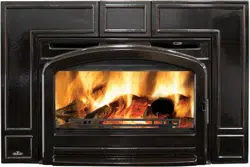Loading ...
Loading ...
Loading ...

W415-1087 / A / 06.06.13
19
EN
You can now add larger pieces of wood and operate the appliance normally. Once the appliance is entirely hot,
it will burn very effi ciently with little smoke from the chimney. There will be a bed of orange coals in the fi rebox
and secondary fl ames fl ickering just below the top baffl es. You can safely fi ll the fi rebox with wood to the top
of the door and will get best burns if you keep the appliance surface temperatures between 500°F (260°C) and
600°F (315°C).
Without an appliance thermometer, you are working blind and have no idea of how the appliance is operating!
An appliance thermometer offers a guide to performance.
Can’t get the fi re going? Use more kindling and paper. Assuming the chimney and vent are sized correctly
and there is suffi cient combustion air, the lack of suffi ciently dry quantities of small kindling is the problem.
Thumb size is a good gauge for small kindling diameter.
Can’t get heat out of the appliance? One of two things may have happened. The appliance door may have
been closed prematurely and the appliance itself has not reached optimum temperature. Reopen the door and/
or draft control to re-establish a brisk fi re. The other problem may have been wet wood. The typical symptom is
sizzling wood and moisture being driven from the wood.
6.1 AIR CONTROL
Draft is the force which moves air from the fi rebox up through the chimney. The amount of draft in your
chimney depends on the length and diameter of chimney, local geography, nearby obstructions and other
factors. Adjusting the air control all the way to the right reduces the
temperature. The draft can be adjusted from low to high by moving the
handle from right to left. Inadequate draft may cause back-puffi ng into
the room through the appliance and chimney connector points and may
cause plugging of the chimney. Too much draft may cause an excessive
temperature in the appliance, glowing red appliance parts or chimney
connectors or an uncontrollable burn which can lead to a chimney fi re or
permanent damage to the appliance. Do not operate your appliance for
longer than 30 minutes with the air control on “HIGH” (fully open).
6.2 FIRE EXTINGUISHERS / SMOKE DETECTORS
!
WARNING
DO NOT STORE FUEL WITHIN THE CLEARANCE TO COMBUSTIBLES, OR IN THE SPACE REQUIRED
FOR RE-FUELING AND ASH REMOVAL.
BURNING WET, UNSEASONED WOOD CAN CAUSE EXCESSIVE CREOSOTE ACCUMULATION. WHEN
IGNITED IT CAN CAUSE A CHIMNEY FIRE THAT MAY RESULT IN A SERIOUS HOUSE FIRE.
91.1
A
ll homes with a solid fuel burning appliance should have at least one fi re extinguisher in a central location,
known to all, and at least one smoke detector in the room containing the appliance. If it sounds an alarm,
correct the cause but do not de-activate or relocate the smoke detector.
6.3 FUEL
AIR CONTROL
For maximum effi ciency, when the appliance is thoroughly hot, load it fully to the top of the door opening and
burn at a medium low setting. Maximum heat for minimum fuel (optimum burn) occurs when the appliance top
temperature is between 500°F (260°C) and 600°F (315°C). The bricks will be nearly all white and the glass
mostly clear. The whiteness of the bricks and the cleanliness of the glass are good indicators of your operating
effi ciency. Not enough heat is produced when only one or two pieces of wood are burned or the wood may not
burn completely. A minimum of three pieces are needed to encase a bed of coals that sustains the fi re.
NOTE: When loading the appliance, keep fuel back from the glass. If coals are to accumulate on the front
lip, there is a chance they will fall out when the door is opened.
Loading ...
Loading ...
Loading ...
